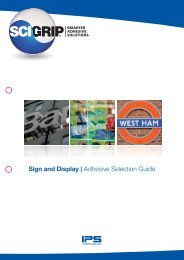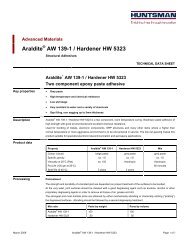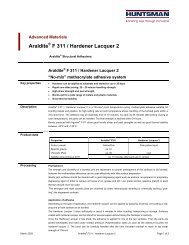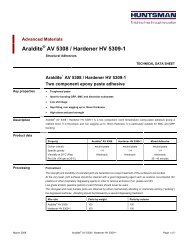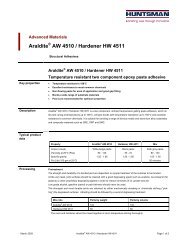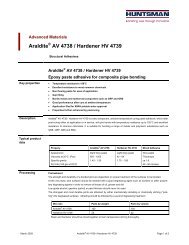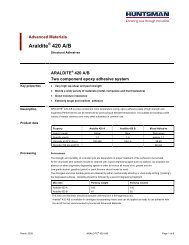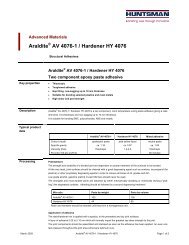Araldite F349 / Hardener Lacquer 2 - DanLube
Araldite F349 / Hardener Lacquer 2 - DanLube
Araldite F349 / Hardener Lacquer 2 - DanLube
- No tags were found...
You also want an ePaper? Increase the reach of your titles
YUMPU automatically turns print PDFs into web optimized ePapers that Google loves.
Advanced Materials<strong>Araldite</strong> ® <strong>F349</strong> / <strong>Hardener</strong> <strong>Lacquer</strong> 2<strong>Araldite</strong> ® Structural AdhesivesKey properties<strong>Araldite</strong> ® <strong>F349</strong> / <strong>Hardener</strong> <strong>Lacquer</strong> 2No-mix methacrylate adhesive system for metals and plasticswith good chemical resistance<strong>Hardener</strong> can be applied to substrate and stored for up to 30 daysLong open time, 60-90 minutes handling strengthHigh shear strength strengthBonds well to a wide range of metals and plastic materialsExcellent chemical resistanceDescriptionAgomet ® M with hardener lacquer is a No-mix room temperature curing, methacrylate adhesive suitable for bondingmetals (except copper/zinc/tin-alloys).and plastics. Its setting rate at room temperature allows handling of thebonded parts within 60-90 minutes. Agomet ® M is especially well suited for bonding rigid plastics and metals. Theproduct displays excellent resistance to chemicals. The final strength is reached after approximately 10 hours. It canbe applied with standard mixing/dispensing equipment. Agomet ® M features a very good thermal stability.Product dataProperties <strong>Araldite</strong>® <strong>F349</strong> <strong>Hardener</strong> <strong>Lacquer</strong> 2Colour (visual) Pale yellow liquid Pale yellow liquidSpecific gravity 0.98 -Viscosity (Pas) 10-15 LowGelation time (mins) at 23°Cca. 60-90 minutes after parts are in contactProcessingPretreatmentThe strength and durability of a bonded joint are dependant on proper pretreatment of the surfaces to be bonded,however the methacrylate adhesives can be used effectively with little surface preparation.Ideally joint surfaces should be cleaned with a good degreasing agent such as acetone, iso-propanol or proprietarydegreasing agent in order to remove all traces of oil, grease and dirt. Low grade alcohol, gasoline (petrol) or paintthinners should never be used.The strongest and most durable joints are obtained by either mechanically abrading or chemically etching ( pickling) the degreased surfaces.Application of adhesiveDepending on the type of application, the hardener lacquer can be applied by spraying, brushing, roll-coating or dippingone or both surfaces to be bonded.The lacquer dries sufficiently in about 4 minutes to allow bonding, transporting or storage. Surfaces coated withhardener lacquer can be stored for several weeks without losing the hardener s reactivity.Once the hardener lacquer has dried, the adhesive is applied to one of the two surfaces. Then the parts are joinedimmediately and fixed under contact pressure. Polymerisation starts as soon as the adhesive touches the hardenerlacquer. The bond can be carefully handled after the time indicated overleaf to reach to lap shear strength ofMarch 2009 <strong>Araldite</strong> ® <strong>F349</strong> / <strong>Hardener</strong> <strong>Lacquer</strong> 2 Page 1 of 5
1N/mm².A layer of adhesive 0.15 to 0.25 mm thick will normally impart the greatest lap shear strength to a joint, althoughjoints of up to 0.8mm gap can be assembled. For joint gap widths up to 0.4 mm, application of hardener lacquer tojust one surface is sufficient. To bridge wider joint gaps, hardener lacquer must be applied to both parts. Gaps widerthan 0.8 mm should be avoided since the adhesive may not fully cure.The joint components should be assembled and clamped as soon as the adhesive has been applied. An even contactpressure throughout the joint area will ensure optimum cure.If adhesive is applied to one surface and hardener lacquer to the other, this method of separate processing allowsbonding operations practically independent of the pot life.Mechanical processingSpecialist firms have developed metering, spraying and spreading equipment that enables the bulk processing ofadhesive. We will be pleased to advise customers on the choice of equipment for their particular needs.Equipment maintenanceAll tools should be cleaned before adhesives residues have had time to cure. The removal of cured residues is adifficult and time-consuming operation.If solvents such as acetone are used for cleaning, operatives should take the appropriate precautions and, in addition,avoid skin and eye contact.Curing speedTimes to minimum shear strengthTemperature C 23Cure time to reachhoursLSS > 1N/mm 2 minutes 70Cure time to reachhoursLSS > 10N/mm 2 minutes 100Typical curedpropertiesUnless otherwise stated, the figures given below were all determined by testing standard specimens made by lapjointing170 x 25 x 1.5 mm strips of aluminium alloy. The joint area was 12.5 x 25 mm in each case.The figures were determined with typical production batches using standard testing methods. They are providedsolely as technical information and do not constitute a product specification.Average lap shear strengths of typical metal-to-metal joints (ISO 4587)Cured for 16 hrs at 40°C and tested at 23 CPretreatment - Sand blastingAluminium L165Steel 37 / 11Stainless steel V4AN Galvanised steelCopperBrassN/mm 20 5 10 15 20March 2009 <strong>Araldite</strong> ® <strong>F349</strong> / <strong>Hardener</strong> <strong>Lacquer</strong> 2 Page 2 of 5
Average lap shear strengths of typical plastic-to-plastic joints (ISO 4587)Cured for 16 hrs at 40°C and tested at 23 CPretreatment - Lightly abrade and isopropanol degrease.CFRPEP-GRPUP-GRPSMCABSPAPCPMMAPVCN/mm0 25 10 15Lap shear strength versus temperature (ISO 4587) (typical average values)Cure: = 16 hrs/40°CN/mm22015105°C0-40 -20 0 23 40 60 80 100Tensile strength ISO R527 /T2/93E-modulusElongation at break:Shore hardess (ISO 686/03)33 MPa (cured 16 hrs at 40°C)2300 MPa (cured 16 hrs at 40°C)1.7%81 DMarch 2009 <strong>Araldite</strong> ® <strong>F349</strong> / <strong>Hardener</strong> <strong>Lacquer</strong> 2 Page 3 of 5
Lap shear strength versus immersion in various media at 23 C otherwise stated (typical average values)30 daysCure: 16 hrs at 40°CN/mm 2 0 5 10 15 20 25 30As-made valueIMSLead free petrolEthyl acetateAcetic acid, 10%XyleneLubricating oilParaffinWater at 23°CWater at 60°CWater at 90°CMarch 2009 <strong>Araldite</strong> ® <strong>F349</strong> / <strong>Hardener</strong> <strong>Lacquer</strong> 2 Page 4 of 5
StorageHandlingPrecautions<strong>Araldite</strong> ® <strong>F349</strong> and <strong>Hardener</strong> <strong>Lacquer</strong> 2 may be stored for up to 36 months at 2-8°C provided the components arestored in sealed containers. When stored at 23°C the life is a maximum of 6 months. The expiry date, assuming 2-8 C storage, is indicated on the packaging.CautionOur products are generally quite harmless to handle provided that certain precautions normally taken when handlingchemicals are observed. The uncured materials must not, for instance, be allowed to come into contact with foodstuffsor food utensils, and measures should be taken to prevent the uncured materials from coming in contact withthe skin, since people with particularly sensitive skin may be affected. The wearing of impervious rubber or plasticgloves will normally be necessary; likewise the use of eye protection. The skin should be thoroughly cleansed at theend of each working period by washing with soap and warm water. The use of solvents is to be avoided. Disposablepaper - not cloth towels - should be used to dry the skin. Adequate ventilation of the working area is recommended.These precautions are described in greater detail in the Material Safety Data sheets for the individualproducts and should be referred to for fuller information.Huntsman Advanced Materials warrants only that its products meet the specifications agreed with the buyer. Typical properties,where stated, are to be considered as representative of current production and should not be treated as specifications.The manufacture of materials is the subject of granted patents and patent applications; freedom to operate patented processesis not implied by this publication.Huntsman Advanced Materials(Switzerland) GmbHKlybeckstrasse 2004057 BaselSwitzerlandTel: +41 (0)61 299 11 11Fax: +41 (0)61 299 11 12www.huntsman.com/advanced_materialsEmail: advanced_materials@huntsman.comWhile all the information and recommendations in this publication are, to the best of our knowledge, information and belief,accurate at the date of publication, NOTHING HEREIN IS TO BE CONSTRUED AS A WARRANTY, EXPRESS OROTHERWISE.IN ALL CASES, IT IS THE RESPONSIBILITY OF THE USER TO DETERMINE THE APPLICABILITY OF SUCH INFORMATIONAND RECOMMENDATIONS AND THE SUITABILITY OF ANY PRODUCT FOR ITS OWN PARTICULAR PURPOSE.The behaviour of the products referred to in this publication in manufacturing processes and their suitability in any given end-useenvironment are dependent upon various conditions such as chemical compatibility, temperature, and other variables, which arenot known to Huntsman Advanced Materials. It is the responsibility of the user to evaluate the manufacturing circumstances andthe final product under actual end-use requirements and to adequately advise and warn purchasers and users thereof.Products may be toxic and require special precautions in handling. The user should obtain Safety Data Sheets from HuntsmanAdvanced Materials containing detailed information on toxicity, together with proper shipping, handling and storage procedures,and should comply with all applicable safety and environmental standards.Hazards, toxicity and behaviour of the products may differ when used with other materials and are dependent on manufacturingcircumstances or other processes. Such hazards, toxicity and behaviour should be determined by the user and made known tohandlers, processors and end users.Except where explicitly agreed otherwise, the sale of products referred to in this publication is subject to the general terms andconditions of sale of Huntsman Advanced Materials LLC or of its affiliated companies including without limitation, HuntsmanAdvanced Materials (Europe) BVBA, Huntsman Advanced Materials Americas Inc., and Huntsman Advanced Materials (HongKong) Ltd.Huntsman Advanced Materials is an international business unit of Huntsman Corporation. Huntsman Advanced Materials tradesthrough Huntsman affiliated companies in different countries including but not limited to Huntsman Advanced Materials LLC inthe USA and Huntsman Advanced Materials (Europe) BVBA in Europe.<strong>Araldite</strong> are registered trademarks of Huntsman Corporation or an affiliate thereof.Copyright © 2008 Huntsman Corporation or an affiliate thereof. All rights reserved.March 2009 <strong>Araldite</strong> ® <strong>F349</strong> / <strong>Hardener</strong> <strong>Lacquer</strong> 2 Page 5 of 5



